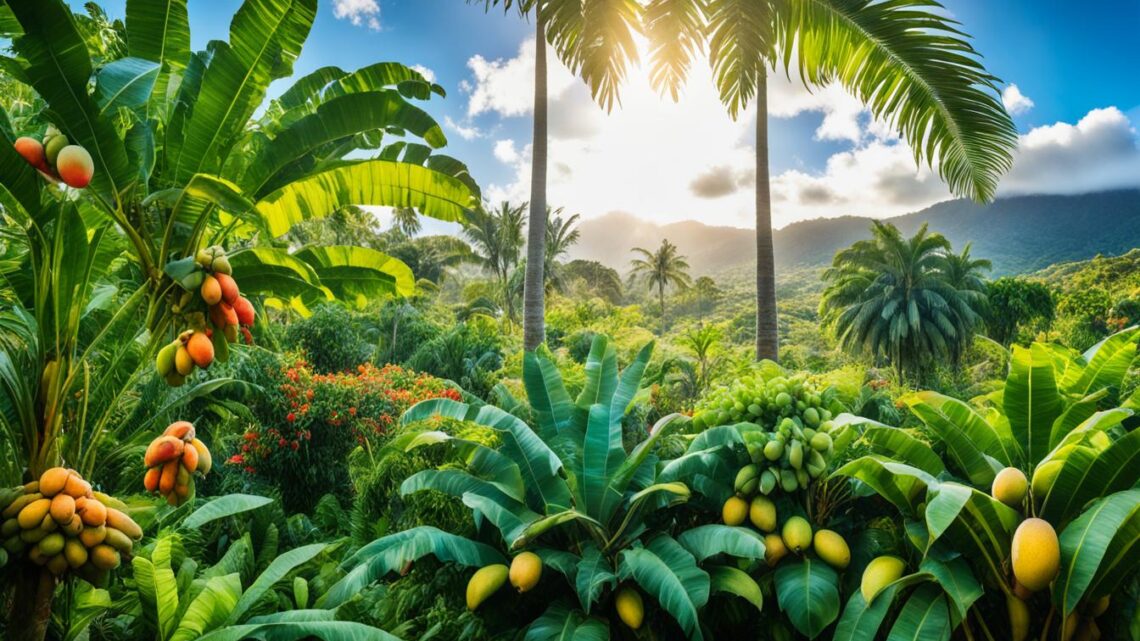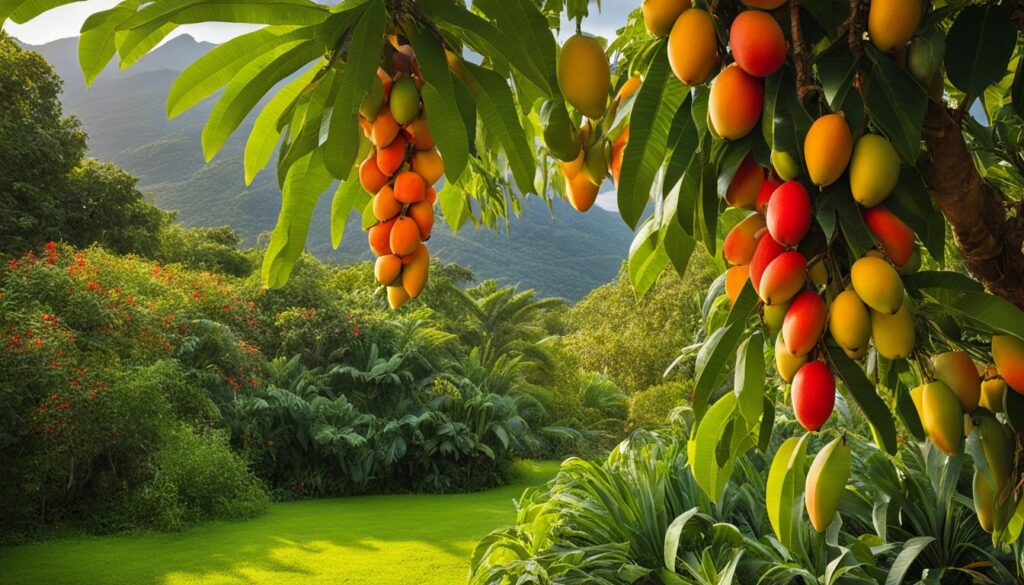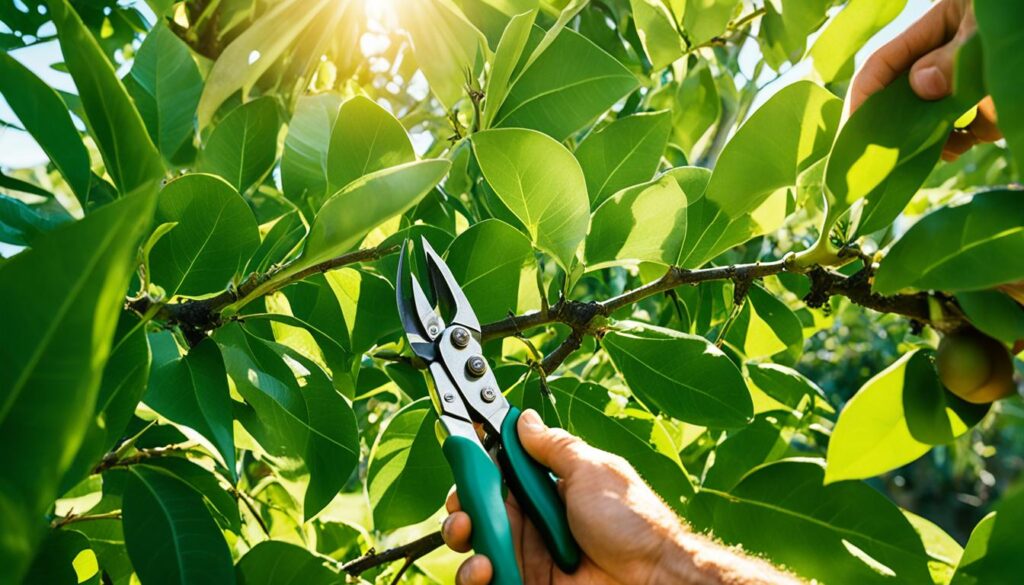
Are you ready to start a journey to grow sweet, juicy tropical fruits? This guide is for both new and experienced gardeners. It will teach you how to grow your own tropical fruit trees.
Trees like mangoes, papayas, bananas, coconuts, pineapples, guavas, avocados, and citrus fruits can make your backyard beautiful. They bring lots of flavors and textures. Imagine picking fresh fruit from your own trees.
This guide will take you into the world of fruit trees. We’ll talk about dwarf varieties and how to start your own tropical fruit garden. You’ll learn how to grow a lot of fruit and enjoy the fruits of your hard work.
Embracing the Tropical Fruit Tree Bounty
Fruit trees are a dream for gardeners. They offer beauty, fragrance, and tasty harvests. From apples and pears to exotic citrus and stone fruits, each tree adds its own charm and flavors to your garden. It’s key to pick trees that do well in your area’s climate and soil.
In New Zealand, many fruit trees can grow well. This is thanks to the country’s mild climate and different landscapes.
Understanding the World of Fruit Trees
Exploring fruit trees shows a wide range of choices. Each has its own taste, growth style, and care needs. Whether you like mangoes, papayas, bananas, or coconuts, there’s a tree for you.
Dwarf Fruit Trees: A Space-Saving Marvel
If you have little space or want a smaller orchard, dwarf fruit trees are perfect. They give you tasty fruits but take up less room. Great for small gardens, patios, or containers, these trees add beauty and fresh produce to your space.
| Fruit Tree | Ideal Climate | Soil Preference | Sunlight Requirement |
|---|---|---|---|
| Moonglow Pear | Temperate | Well-drained | Full sun |
| Apricot | Temperate | Slightly alkaline | Full sun |
| Pawpaw | Partial shade | Moist, fertile | Partial shade |
| Persimmon | Temperate | Well-drained | Full sun |

Choosing the right fruit trees for your area and space opens up many possibilities. It turns your garden into a lush, fruitful oasis full of tropical tastes and colors.
Planting Tropical Fruit Trees in New Zealand
New Zealand is great for growing many tropical fruit trees. Before picking your trees, think about your area’s climate. The North Island is warm and good for citrus, avocados, and feijoa. The South Island is cooler, perfect for apples, pears, and stone fruits.
Choosing the right fruit trees for your climate makes your orchard successful and full of life.
Fruit Trees in New Zealand: Climate Matters
In the North Island, the warm and humid weather is perfect for tropical and subtropical fruit trees. Citrus, avocados, and feijoa love this climate. The South Island is cooler and great for apples, pears, and stone fruits like peaches and plums.
When picking fruit trees for your garden, look for ones that fit your local climate. This way, your trees will grow well and give you lots of tasty fruit every year.

Spacing Considerations for Tropical Fruit Trees
Growing tropical fruit trees needs careful thought about space. These trees don’t always need a lot of room. The right space depends on the tree type, rootstock, and how you prune them.
How Much Room Do Fruit Trees Need?
Apple and pear trees usually need 20 to 25 feet between each other for best growth and air flow. Stone fruits like peaches and plums might need a bit more space, from 15 to 25 feet apart.
If you have little space, dwarf fruit trees are a great choice. They can be planted just 10 feet apart. These smaller trees give a big harvest without taking up too much room.
- Apple trees: 20 to 25 feet apart (semi-dwarf: 15 feet, dwarf: 10 feet)
- Apricot trees: 20 to 25 feet apart (dwarf: 8 to 10 feet)
- Avocado trees: 30 feet apart (dwarf: 10 feet)
It’s important to space trees right for them to get enough sunlight, nutrients, and air. Think about how big your trees will get to plan your orchard well. This way, you get the most from your space and keep things easy to manage.

Planting trees close together means more pruning work, but it also stops weeds, uses up less nutrients, and saves water by shading the ground. Planting trees far apart is cheaper upfront and needs less pruning. But, it might let weeds grow and use more water and nutrients.
Providing Support for Thriving Tropical Fruit Trees
For your tropical fruit trees to live long and produce well, they need the right support. Young trees do great with staking. This protects them from strong winds and helps them grow straight up. Use strong stakes and tie them to the trunk with soft ties to avoid harming the bark.
When your fruit trees get bigger, think about using trellises or cages for their heavy branches. These help prevent branches from breaking. They also help train the tree to get enough sunlight and air. Good tree support lowers disease risk and keeps the tree healthy. This means you’ll get more fruit.
| Support Method | Benefits |
|---|---|
| Staking | Provides stability for young trees, protects against wind damage, encourages straight growth |
| Trellises | Supports heavy fruit-bearing branches, improves air circulation and sunlight exposure |
| Cages | Prevents branch breakage, maintains the desired tree shape and size |
Adding these support systems to your tropical fruit trees helps them stay healthy and productive for a long time.

The Art of Pruning Tropical Fruit Trees
Pruning is key to caring for tropical fruit trees. It shapes their growth, cuts out dead or sick branches, and encourages new, strong growth. It also lets more sunlight in and improves air flow, which helps prevent diseases that love dark, wet spots.
For beginners, start with the basics. Cut out dead, damaged, or crossing branches. This makes the tree’s canopy open, letting sunlight reach everywhere. Thinning fruit also makes the fruit bigger and better, stopping disease from spreading.

Managing the tree’s canopy is vital when pruning tropical fruit trees. Here are the recommended heights for different trees:
- Avocado trees: 10-15 feet
- Citrus trees: 10-14 feet
- Guava trees: 3-12 feet
- Mango trees: 6-15 feet
- Cocoa trees: 6-8 feet
- Black Sapote trees: 12-15 feet
- Atemoya trees: 8-12 feet
- Longan trees: 10-15 feet
- Jaboticaba trees: 8-12 feet
- Mamoncillo trees: 12-15 feet
- Cashew trees: 10-12 feet
Removing more stem during pruning makes new growth stronger. But, cutting too much or to the ground can be risky. Some trees might not grow back well or at all.
Learning to prune well will help you keep your tropical fruit trees healthy and full of fruit.
Nourishing Your Tropical Fruit Orchard
Fertilizing and Watering: Nourishing Your Orchard
To keep your tropical fruit orchard healthy, you need to feed your trees right. Start with a slow-release fertilizer in early spring. Choose a fertilizer made for fruit trees and follow the instructions for how much to use, based on your trees’ age and size. It’s also key to water your trees deeply and often, especially when it’s dry.
Water your new trees often until they grow strong roots. Mulching around your trees helps keep the soil moist, stops weeds, and keeps the soil cool. Use a 2-4 inch layer of organic mulch like wood chips or shredded bark. With the right fertilizer and water, your trees will grow well and give you lots of fruit.
- Apply a slow-release fertilizer formulated for fruit trees in early spring.
- Provide consistent, deep watering to newly planted trees until the roots are established.
- Use a 2-4 inch layer of organic mulch around the base of your trees to retain moisture and regulate soil temperature.
- Maintain healthy soil to support the overall vigor and productivity of your tropical fruit orchard.
Tropical Fruit Trees: Pest and Disease Management
Keep an eye on your tropical fruit trees to spot pests and diseases early. Pests like aphids, mites, and caterpillars can be a problem. Fungal diseases, such as powdery mildew and brown rot, can also hurt the quality of your fruit. Using organic insecticides and fungicides is a good way to keep things safe for the environment while fighting these pests and diseases.
Using Integrated Pest Management (IPM) can help keep your orchard healthy. This includes adding beneficial insects or using pheromone traps. Always check your tropical fruit trees for any signs of pests or diseases. Then, act quickly to stop problems from getting worse.
| Pest or Disease | Impact | Organic Solution |
|---|---|---|
| Sooty Mold | Fungus caused by sucking/piercing insects | Introduce beneficial insects, use horticultural oils |
| Sri Lankan Weevil | Leaf damage on lychees, longans, and other trees | Break the life cycle, dispose of damaged fruit |
| Annona Seed Borer | Mummification of sugar apple | Bagging and disposing of damaged fruit |
| Avocado Lace Bugs | Severe leaf damage before blooming | Use insecticidal soaps, introduce predatory insects |
By being alert and using organic solutions for pest management and disease control, you can keep your tropical fruit trees healthy. This way, you’ll get a great harvest.
Harvesting the Tropical Fruit Tree Bounty
The long-awaited moment has arrived – it’s time to harvest your tropical fruit trees! The best time to pick depends on the fruit type. Learn when each fruit in your orchard is ready.
When picking, be gentle to avoid bruising the fruit. Use pruning shears or scissors to carefully cut the fruit from the tree. For fruits like apples and pears, just twist them off. Store your fresh finds in a cool, dry spot or the fridge to keep them fresh longer.
Not all fruit ripens at the same time. Some fruit trees may need a second or third picking. Fruits like persimmons and pears get sweeter after they’re picked.
Young trees start slow, especially those under 5 years old. Their fruits might look different and be smaller than store-bought ones. The best time to pick fruits is usually from spring to fall, but it depends on where you are.
Adding fresh fruits to your recipes is a great way to enjoy them before they go bad. Berries freeze well, so wash and dry them before freezing in containers.
A fruit is ripe when it tastes and feels its best. Ripe fruits come off the tree easily. Different fruits need to be picked at different times – some before they’re ripe, others when they are, and some anytime.
Beginner-Friendly Tropical Fruit Trees
Pear Trees: The Easiest Tropical Fruit
If you’re new to gardening, pear trees are a great pick. They are easy to grow and produce fruit. Asian pears are a type of pear that grows well.
Pears are mostly free from diseases, except for fire blight. This disease turns the stem tips black and kills them. But, ‘Kieffer’ pears are resistant to fire blight. They are a good choice for gardeners in the continental United States.
Most pear trees, including ‘Kieffer’, don’t need another tree to pollinate them. But, you’ll get more fruit if you have two trees for cross-pollination.
Apple Trees: A Slight Step Up
Apples are a bit harder to grow than pears. Perfect Plants has eight apple tree types, like ‘Anna’ and ‘Ein Shemer’, for the South. For the North, they have ‘Fuji’ and ‘Granny Smith’.
If you want a self-fertile apple tree, try the Golden Delicious. Apple trees sleep in the winter. You need to know your local «chill hours» and hardiness zone. Check out the Apple Tree Grow Guide for tips on growing different apples.
Tropical Fruit Trees: Fig Trees and Citrus Delights
Want to add a touch of the tropics to your garden? Look into fig trees and citrus fruits. These tropical fruit trees grow well in many climates. They’re perfect for new gardeners.
Fig trees are easy to grow. They resist disease, tolerate drought, and pollinate themselves. The ‘Brown Turkey’ fig grows fast and produces a lot. For cooler areas, try the ‘Chicago Hardy’ fig, which can grow in USDA zone 5.
In USDA zones 8 through 11, explore citrus fruits like tangerines and oranges. These self-pollinating trees need little care. They’re great for any tropical garden.
- Fig trees are disease-free, drought-tolerant, and self-pollinating.
- The ‘Brown Turkey’ fig is a fast-growing, highly productive variety.
- The ‘Chicago Hardy’ fig is a good choice for cooler climates (USDA zone 5).
- Citrus fruits like tangerines, oranges, and lemons thrive in USDA zones 8-11.
- Citrus fruit trees are drought-tolerant and self-pollinating.
Love the sweet taste of figs or the zesty flavor of citrus? These tropical fruit trees will make your garden feel like paradise. They’re easy to care for and give lots of fruit. They’re ideal for anyone starting with fruit trees.
The Tropical Fruit Tree Lineup for Beginners
Peach trees are perfect for gardeners who are a bit more advanced. They grow well in USDA zones 5-9, fitting many climates. These trees like full sun but can also grow in partial shade.
They need regular water and should be pruned properly. But, these tasks are easy to learn. Some good peach trees for beginners are the White Lady Peach, Reliance Peach, and Contender Peach.
Grape vines are also great for beginners. They are easy to grow and don’t need another tree to help them. You can choose from varieties like Niagara Grape and Catawba Grape.
Adding pear, apple, fig, citrus, peach, and grape vines to your garden makes it diverse and fruitful. With the right care, these trees will give you lots of fruit every year.



